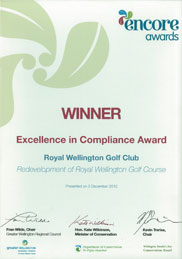GOLF CHAMPIONSHIPS ON SMGD COURSES:
At Close House – Colt Course. Sept 2017. A prestigious European Tour Championship hosted by Lee Westwood.
Broadcast worldwide from Royal Wellington Golf Club, NZ. October 2017. WOW!
The legacy continues.
Co-hosted at the award-winning Millbrook Resort near Queenstown, NZ. 2014 – 2023.
The Dogleg
Published in THE CUT, June 2006
Golf is a game of skill. Control of the ball in the air and on the ground is what separates one level of player from another. The architect aims to test each players control through the use of various design features. As elementary as it may sound, I believe no design feature is more important in achieving this than the simple dogleg.
Taking its name from the shape of a canine’s rear limb, a dogleg is essentially a bent golf hole. It’s a hole with a kink. The doglegged hole is not straight from tee to green. I am not aware that the degree of the kink has ever been formally defined but I would propose it must be more than 5 degrees and less than 90. Most commonly they are between 10 and 45 degrees.
In golf course design speak, the point at which the holes ‘kinks’ is called the ‘turning point’. The location of the turning point can vary. If a turning point is closer to the teeing grounds, a longer hitter may attempt to cut the corner. Should the turning point be located closer to the green, players will often attempt to hit over the corner with their second shots. Conventionally however, most holes dogleg at the landing area.
Regardless of where the turning point is however, a hole with a turning point will create a greater premium of accuracy and control than a straight hole, and here’s why. Not considering the frequent incorporation elevation change in doglegs, the presence of a turning point means golfers can gain greater advantages by hitting their ball to a certain side of the fairway. i.e. should the hole turn left, generally the advantage goes to the golfer who can hit their ball closest to the left-hand side of the fairway as the approach from this point the approach shot is shorter. Visa versa if the hole doglegs right.
In addition to strategic merit, American architect Robert Trent Jones once wrote about doglegs saying, ‘Dogleg holes, those that bend to the right of left, … offer the architect a grand opportunity to practice deception’. Distance makers, yardage guides and GPS equipment, have all diluted the power of the illusion created by swales, humps, clever contouring in the fairway and greens, and the placement of bunkers, but by skilfully designing the turning point of the hole, the architect can still make it appear that a shot must go in a certain direction – closely skirting the corner of a bunker or bending the ball around the corner for example – when really the shot straight down the fairway will get the ball just as close to the green. This kind of deception is minimised by course knowledge, but that requires thinking, which conveniently is the entire aim of the process.
In terms of defending doglegs, most are protected at the landing area. This can be achieved via the placement of trees, bunkers or rough grass. On new designs where trees are limited, bunkering usually does this work. A good stand of trees can nicely define the inside of a dogleg however. If bunkers define the inside of the dogleg, bunkers needn’t define the outside also. Keeping the grass short in front of any trees is adequate defence as the off-line shot will run into the trees and probably be in more trouble here than it would come to in a bunker. (Note- Augusta National, which relative to most courses has very few bunkers, uses trees and slope to defend its doglegs.) Often the elevation change and contours of the land will influence how an architect treats these landing areas.
Doglegs do not always need to be defended at the landing area. If the green is defended say on the right side by a bunker or mound, this puts a premium on golfers hitting their tee shot to left side of the fairway to avoid having to hit over the hazard. This design style is called ‘deferred danger’ and can effectively turn a straight hole into a dogleg. As with most things, variety is the key. And to this extent, bunkers on the inside of a dogleg or by the green that need to be hit over can provide the most interest. No hazard demands more attention than the one on the direct line.
Whether the hole is a Par 4 or 5, doglegs make a golfer think. The options may be subtle, but good doglegs require all golfers to develop a strategy before hitting the ball– even to those familiar with the course. No other type of hole demands this degree of attention and rewards control as much. Nobody likes playing a dog, but a good course has lots of doglegs.
AWARDS
 Winner
Winner
Excellence in Compliance Award
Royal Wellington Golf Club
 Scott awarded by GEO as a Sustainable Golf Champion
Scott awarded by GEO as a Sustainable Golf Champion
PUBLICATIONS
 St Andrews
St Andrews
The Evolution of the Old Course
by Scott Macpherson
TESTIMONIALS
"When I was looking for a golf architect I wanted someone who would understand the landscape and have the flair to design a course of the highest quality in terms of; aesthetics, a player's and playing perspective; being practical in terms of forward maintenance; and to bring the construction in on time and on budget. Scott is that man! And what's more he brings competence and professionalism and an easy management style and enthusiasm that is infectious and at no extra charge – a little bit of magic to it all!"
Derek Young, Chairman Kersewell Resort Group, Scotland, UK.



